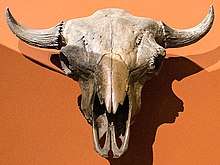Bison occidentalis
Bison occidentalis is an extinct species of bison that lived in North America, and potentially in Siberia[2] and the Japanese archipelago[3] from about 11,000 to 5,000 years ago, spanning the end of the Pleistocene to the mid-Holocene.[4]
| Bison occidentalis Temporal range: Pleistocene-Holocene | |
|---|---|
| Scientific classification | |
| Kingdom: | Animalia |
| Phylum: | Chordata |
| Class: | Mammalia |
| Order: | Artiodactyla |
| Family: | Bovidae |
| Subfamily: | Bovinae |
| Genus: | Bison |
| Species: | †B. occidentalis |
| Binomial name | |
| †Bison occidentalis Lucas, 1898 [1] | |
Characteristics

Likely evolving from Bison antiquus, B. occidentalis was smaller overall from its most direct ancestor, but was similar to the distant ancestor the steppe bison (Bison priscus) in size. B. occidentalis had a highly variable morphology, and their horns, which pointed rearward, were much thinner and pointed than other Pleistocene species of bison.[4]
B. occidentalis, like other bison species, may have existed in small, scattered populations and been unable to increase in numbers until after the Pleistocene epoch ended 10,000 years ago because of competition with other large grazers during the Pleistocene.[5]
Evolution
B. occidentalis's size depletion from Bison antiquus was likely caused by the influence of human pressures and may be related to the cease of the Folsom culture.[6] The smaller size likely helped B. occidentalis to flourish in number and shaping of modern American bisons after migrating into North America, as Bison antiquus faced population depletion by human hunting and was replaced by B. occidentalis in ecological niches and hybridization of the two bison species resulted in the appearance of today's smaller Bison bison.[6] The wood bison (Bison bison athabascae) preserved some of original traits of B. occidentalis which was more similar to the phenotype of the steppe bison, hence being more primitive than the plains bison (Bison bison bison).[2]
More recently ancient DNA studies have proven interbreeding between B. occidentalis and ancestral modern bison, so B. occidentalis was proposed to have been a localized offshoot of B. antiquus and part of the transition from that chronospecies to modern bison.
References
- Stephen Austin Hall (1972). "Holocene Bison occidentalis from Iowa". Journal of Mammalogy. 53 (3): 604–606. JSTOR 1379052.
- C. G Van Zyll de Jong , 1986, A systematic study of recent bison, with particular consideration of the wood bison (Bison bison athabascae Rhoads 1898), p.53, National Museum of Natural Sciences
- Hasegawa, Y.; Okumura, Y.; Tatsukawa, H. (2009). "First record of Late Pleistocene Bison from the fissure deposits of the Kuzuu Limestone, Yamasuge,Sano-shi,Tochigi Prefecture,Japan" (pdf). Bull.Gunma Mus.Natu.Hist. Gunma Museum of Natural History and Kuzuu Fossil Museum (13): 47–52. Retrieved 2018-12-03.
- McDonald, J. N. (1981). North American bison: their classification and evolution. Berkeley: University of California Press. ISBN 0520040023.
- Lott, Dale F. (2002). American Bison: A Natural History. Berkeley: University of California Press. ISBN 0-520-23338-7.
- Valerius Geist, 1996, Buffalo Nation, Voyageur Press